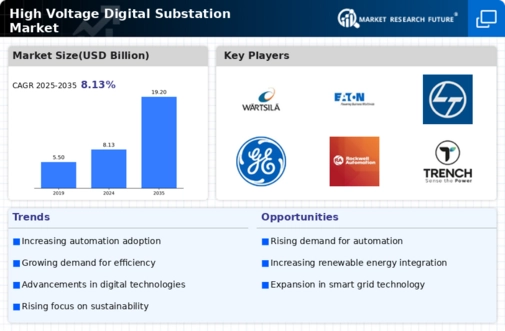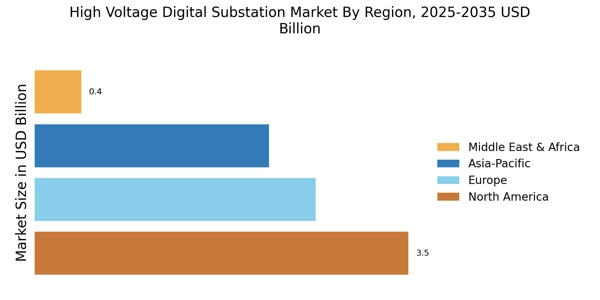Rising Demand for Renewable Energy
The increasing emphasis on renewable energy sources is a pivotal driver for the High Voltage Digital Substation Market. As nations strive to meet ambitious carbon reduction targets, the integration of renewable energy into existing grids becomes essential. High voltage digital substations facilitate this transition by enabling efficient management of variable energy sources such as wind and solar. According to recent data, the share of renewables in the energy mix is projected to reach 50% by 2030 in several regions. This shift necessitates advanced substations that can handle the complexities of renewable integration, thereby propelling the demand for high voltage digital substations.
Government Initiatives and Regulatory Support
Government initiatives and regulatory support play a crucial role in shaping the High Voltage Digital Substation Market. Many governments are implementing policies that promote the modernization of electrical infrastructure, including the deployment of digital substations. Incentives such as tax breaks, grants, and subsidies are being offered to utilities that invest in advanced technologies. For instance, regulatory frameworks in various regions are increasingly favoring the adoption of digital substations to enhance grid reliability and resilience. This supportive environment is likely to stimulate market growth, as utilities seek to comply with evolving regulations and improve service delivery.
Increased Focus on Grid Resilience and Reliability
The increased focus on grid resilience and reliability is driving the High Voltage Digital Substation Market. As extreme weather events become more frequent, the need for robust electrical infrastructure has never been more critical. High voltage digital substations enhance grid resilience by incorporating advanced monitoring and control systems that can quickly respond to disruptions. The market is witnessing a shift towards solutions that not only improve reliability but also reduce the risk of outages. Industry reports suggest that investments in grid resilience are expected to reach billions in the next decade, highlighting the importance of high voltage digital substations in future-proofing electrical networks.
Growing Urbanization and Infrastructure Development
The trend of growing urbanization and infrastructure development is a significant driver for the High Voltage Digital Substation Market. As urban areas expand, the demand for reliable and efficient power supply increases. High voltage digital substations are essential for managing the increased load and ensuring stable electricity distribution in densely populated regions. Recent statistics indicate that urban populations are expected to rise by 2.5 billion by 2050, necessitating substantial investments in electrical infrastructure. This urban growth presents a lucrative opportunity for the high voltage digital substation market, as utilities strive to upgrade their systems to meet the rising demand.
Technological Advancements in Substation Automation
Technological advancements in substation automation are significantly influencing the High Voltage Digital Substation Market. Innovations such as digital relays, smart sensors, and advanced communication technologies enhance operational efficiency and reliability. These advancements allow for real-time monitoring and control, reducing downtime and maintenance costs. The market for substation automation is expected to grow at a compound annual growth rate of over 8% in the coming years, indicating a robust demand for high voltage digital substations equipped with cutting-edge technologies. This trend underscores the necessity for utilities to modernize their infrastructure to remain competitive and efficient.


















Leave a Comment